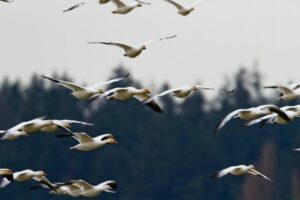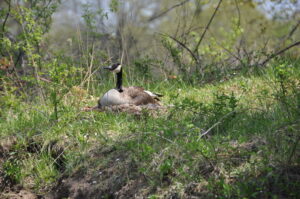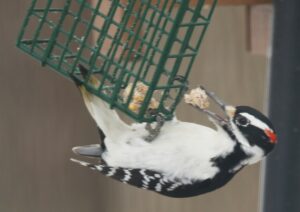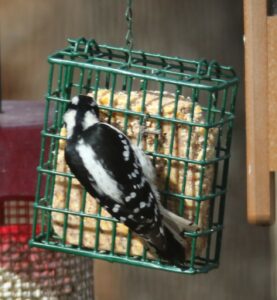Spring is on its way!

The Snow Geese are now flying in huge flocks high over our house – all leisurely heading north to their nesting grounds on the tundra of northern Canada. And our Canada Geese are beginning what Cleon and I have named “The Great Goose Wars”. Each late winter, the large flocks of Canada Geese – which are mostly families who have joined together from last year – start to break up. Canada Geese do not breed until they are about 3-4 years old, so nonbreeding birds will gather into smaller flocks for the spring and summer. Canada Geese most often mate for life and this is the time these mated pairs separate themselves from all other geese and start looking for nesting sites. For the 20 years we have lived here, we have had a pair nesting on our point where the lake and largest inlet join. The nest has been successful about half the time – we do have raccoons who relish eating goose eggs. We also have crows who steal goose eggs.

We live on a peninsula and last year, a second pair tried to start a nest on the shore about 70 feet away from this point. This nest was unsuccessful. She laid 2 eggs and then a rogue goose – most often a male – came in, rolled the eggs out, and destroyed her nest. She immediately abandoned the site. This rogue goose could have been one of the pair nesting on the point or it could have been a goose looking for a nest site. If I had to guess, I would say it was the male of the pair nesting on the point as the site was completely and immediately abandoned for the nesting season. I also think the Canada Goose that lost her nest was young – possibly her first nesting try. Young birds of all species are often unsuccessful in their first nesting try. Evidently it takes experience to successfully choose a nest site, build the nest, and fledge young. I think her male mate was also young because he was not there. Normally, the male is within sight at all times when the female is on the nest. And although she did fight back, she was quickly and easily cowed and defeated. And she saw her eggs being rolled out. As I watched from our window, I felt just terrible for her.
Yesterday, one pair of Canada Geese spent the afternoon at that point – mostly resting, but definitely alert and watching. A second pair camped out for most of the afternoon around the feeders – even rested there for some time and that pair was back this morning. They seem to be looking at a spot on our shore, but farther away from the point. Whoever wins the spot on the point may not allow this, so watch the camera on warm sunny days for fighting in the area behind the feeders. And this gets rough – lots of chasing, tail-feather pulling, hissing, and very loud honking. When they continue a fight into the water, they will also push each other underwater and hold each other down. As far as I have observed, no goose has drowned, but this is serious business.
From now on – on warmer, sunnier days – we will start having geese pushing and shoving each other around in our back yard over the prime nesting spot on the point. And this will get loud. Very loud. And will be a daily occurence from mid March well into April. Today it is cold, damp and completely overcast, so the geese are not as active. But wait until the next sunny day! The Great Goose Wars have begun!


We also have two mated pairs of Downy Woodpeckers at the feeders right now – particularly the log suet feeder. Males and females look alike, but the males have a small red patch on the back of their heads. In the trees around the feeders, the male and female of each pair are interacting quite a bit with each other. The male will chase the female. They will land on the same tree trunk and circle it – sort of chasing and playing with each other. All part of courtship. They are following each other up a branch. Hopefully both pairs will choose to nest here or in our neighbors’ trees.
It is early, but for some birds, nesting season has begun!

